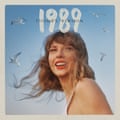I
The doubters have been proven wrong: there is no denying Taylor Swift’s success. Her fan base is extremely devoted and incredibly large. Her songwriting is expertly crafted, with a generic sound but unique lyrics. The impact she has on her fans’ lives is undeniably positive. And not just on her fans, as her current Eras tour is estimated to add approximately $5 billion to the US economy. In fact, her success can’t be argued in any aspect. The recently released movie version of Eras has already surpassed all other concert films in terms of gross earnings in just two weeks.

If the overwhelming success of all this may feel constricting, one could potentially dispute the obsession of near-billionaire Taylor Swift with promoting products, such as numerous limited edition vinyl records and a constant stream of merchandise. However, it is difficult to deny the justification behind her recent re-recordings of her old albums, done in response to her former label Big Machine selling her masters to music manager Scooter Braun, whom she has accused of “constant, manipulative harassment”. While it may be a profitable move, it is ultimately a principled business decision.
Taylor Swift’s fourth re-recording, 1989 (Taylor’s Version), follows a non-chronological release schedule. It comes after Speak Now (originally released in 2010, re-recorded in 2023), Red (2012; 2021), and Fearless (2008; 2021). Fans speculate on the significance of this order. The timeline may have been disrupted by legal battles over plagiarism surrounding the lead single, Shake It Off. However, those lawsuits have since been dropped, and Swift is ready to revisit what she considers her “very first, documented, official pop album.” While some argue that Red holds that title with its popular collaborations with Max Martin, 1989 was a pivotal moment in Swift’s career. It’s possible that you may not have known who Taylor Swift was before this album, but you certainly knew afterwards.
The technical details of this re-recording will only appeal to dedicated fans – a challenge to identify any changes that even Swift, known for creating puzzles for her followers, hasn’t actively promoted. Similar to her previous version of Red, it does not feature the return of Swedish producer Martin, who worked on the album’s popular tracks: Blank Space, Style, Shake It Off, Bad Blood, and Wildest Dreams. Instead, Christopher Rowe joins Swift in producing the album, resulting in a nearly identical sound: occasionally deeper bass and Swift’s voice sounding more mature, but not to the point of being distracting.
For those who are not as fixated, the new release offers a great opportunity to revisit those exceptionally well-crafted songs. Reflecting on the popular culture of the 1980s, which was dominated by the album 1989, also sheds light on the music of that decade. At the time, the album was widely interpreted as heavily influenced by the 80s, which Swift has confirmed, but now it actually seems to primarily represent the music of the 2010s. During this time, there was a prevalence of abrasive, often unappealing synthpop that was almost aggressive in its effectiveness.
In terms of popular music, we currently live in a more considerate era – and Swift has successfully kept up with this change. Her re-recorded albums have all included bonus tracks known as “From the Vaults” – previously unreleased songs from the time of each album’s creation. 1989 (Taylor’s Version) features five of these tracks: Say Don’t Go is a decent but unremarkable collaboration with veteran songwriter Dianne Warren, while the other four, co-written with Jack Antonoff (who contributed two songs to the original 1989 album), are some of Swift’s best work. After 1989, Antonoff went on to produce a number of creative and sophisticated pop songs for artists like Lana Del Rey, Lorde, and St Vincent. These songs are similar in style: intriguing, clever, and more catchy than Antonoff’s usual work, but not quite blockbuster hits – which is likely why they were not included on the original album.
Ignore the newsletter advertisement.
after newsletter promotion
The provocatively-titled “Slut!” is a shimmering tale of inappropriate sexual adventure, as Swift channels Lana Del Rey cosplaying a moonlit ingenue. The remaining three are Swift’s speciality: postmortems of relationships that were patently unhealthy but whose legacy still pulses with dashed promise. Now That We Don’t Talk does it with an uncharacteristically cool falsetto chorus and thrumming synths, and features a nice hook about phoning her mum. Suburban Legends is a doomed schooldays romance full of perfect lines (“I broke my own heart ’cause you were too polite to do it”). Is It Over Now? is a barbed and bitter rinsing of an unfaithful ex over sparse electropop, full of echoing drums and an era-specific alien-like vocal sample.
These subtle, interesting songs lost out to brasher, more basic tracks – Welcome to New York, Style – on the original 1989 tracklist, but who’s to say whether their inclusion would have affected Swift’s trajectory? Clearly she made a pretty good call on that front. This carbon copy of her blockbuster album doesn’t rewrite history but adds some instantly treasurable footnotes.
Source: theguardian.com



















